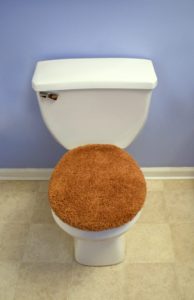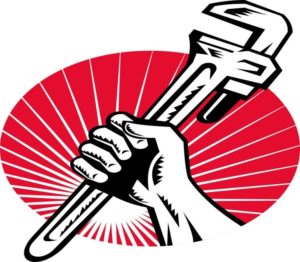Clogged Toilet Response Guide

It is one of those things that will happen to everybody regularly, and will loathe every single time. You go into the bathroom, do your business, flush the toilet… only to find the bowl filling to the brim. You stand there watching in horror while uttering prayers that the bowl does not overflow, and sometimes you are fortunate and it stops, sometimes less so and you have this terrible mess to clean up. Either way, the problem is obvious – your toilet is backed up, and now you have to fix it.
A clogged toilet doesn’t need to be the end of the world, and most of the time it is very easy to fix. For more complicated clogs, however, you may need a professional. This do-it-yourself guide will help walk you through the process of unstopping a clogged toilet. This can save you on costly repairs for what may be a simple fix! It can also help you identify when a clog is beyond your do-it-yourself skills and it is time to call in a professional.
Start with the Plunger
The most well-known and effective tool in your toilet unplugging arsenal is the humble plunger. You will be able to fix most of the toilet clogs you encounter in your lifetime with this one simple tool. In fact, a plunger should be a fixture in every bathroom, so if you do not have on make sure to buy one. When shopping for a new plunger, finding one with an extended flange in front is best as it forms a better seal with most toilets and gives you a little more power with every push.
You’ll naturally want to wait until after the water level in your toilet falls a little (assuming only a partial clog) before you get started. This will help prevent any of the filthy water from splashing out and onto you or all over your floor. Give it about ten minutes and if after that time the water level still hasn’t dropped, you’ll have to take the chance anyway.
Simply insert the plunger into the bowl, forming a tight seal with the drain, and then plunge away. Start with a slow, gentle plunge before working your way up to hard thrusts. This will help to force the air out of the bell and reduce the risk of water splashing about. The drain should clear up with no more than a couple dozen plunges. If it takes longer than that, you may have a deeper problem that requires more work to take care of.
Break Out the Snake
If a plunger is not enough to resolve the clog, the problem may be deeper in the bowl. A snake or auger will be necessary to get at the clog. These devices wind a wire into the toilet in order to get at the problem and either breakup debris or drag it out for disposal. As such, having a waste basket nearby is highly recommended in case your instrument drags out something unsanitary. We recommend using a closet auger over a snake as it is designed to get around that first bend and wind its way deeper into the piping than a standard snake.
Simply insert your auger and turn the device clockwise to feed it through the pipes. As you encounter obstructions or other debris, the auger will carve into them and break apart the debris, or it will find itself wound up on the wire as it is pushed through the drain. Either way, push through slowly so as not to damage the pipes, and when you have broken through retract slowly. Clean the auger and flush – hopefully at this point you’re done! If not you may have to go one step further.
Toilet Removal
If all else fails, you may have to remove the toilet entirely to get at the problem. If you are not confident in your ability to disassemble your toilet and put it back together again, this is the time to call a professional. However, if you are confident then take the time to disassemble the toilet. Do not forget to shut off the water of course – otherwise you will just end up making a huge mess. Once you have successfully removed the toilet, use your auger on the drain pipe to try and get at the problem.
If this still doesn’t fix the problem, or if other fixtures in your home are clogging up at the same time, this indicates a deeper problem and will require a professional to resolve.
Calling in The Pros
There is no shame in calling in a plumber to clear a stopped up drain if it is beyond your ability to manage. Professional plumbers spend their days resolving problems exactly like these, and it is unlikely that you have anything going on they haven’t seen before. Professionals can not only get at the problem, put also put everything back together good as new. Remember that a clogged toilet, if left sitting, can represent a sanitation issue in your household and needs to be resolved as soon as possible!
A clogged toilet is incredibly frustrating to deal with, yet it is something that will probably happen multiple times over the course of your life. This guide will hopefully help you to resolve some of the most common issues related to toilet clogs, and get your bathroom back in working order in no time. If these solutions fail, calling in an expert will make sure the job is done correctly the first time. Remember that there is no shame in calling in the pros to help handle a plumbing problem: if you have managed to go as far as to remove the toilet and put it back together again yourself, you’ve already done more than the average consumer can be expected to handle. If these or other plumbing issues are plaguing your household do not wait. Get in touch with a professional plumbing company like Sailfish Plumbing today!




